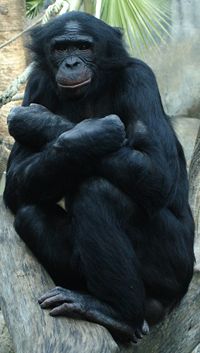Bonobo: Difference between revisions
imported>Briana Rose Cooper |
imported>Briana Rose Cooper No edit summary |
||
| Line 4: | Line 4: | ||
[[Image:Bonobo.jpg|right|thumb|200px|{{#ifexist:Template:Bonobo.jpg/credit|{{Bonobo.jpg/credit}}<br/>|}}A bonobo.]] | [[Image:Bonobo.jpg|right|thumb|200px|{{#ifexist:Template:Bonobo.jpg/credit|{{Bonobo.jpg/credit}}<br/>|}}A bonobo.]] | ||
The '''Bonobo''' (''pan paniscus'') is a part of the ['' | The '''Bonobo''' (''pan paniscus'') is a part of the [''Hominidae''] family which also includes the [Chimpanzee], the [Gibbon], the [Gorilla], the [Orangutan], and the Human. The Bonobo has commonly been linked to the chimpanzee as a "Pygmy Chimpanzee" however this classification has been deteriorating in use due to the fact that the name gives false implications about the species. The pygmy portion of the name was given after a study of a Chimpanzee's bones and a Bonobo's bones. The study found the latter to be more gracile in comparison to the former's, thus the name was given. However the Bonobo is in fact an entirely seperate species from the Chimpanzee, in fact it is as closely related to them as humans are. <ref> {{cite book |author=Leach, Michael |title=The great apes: our face in nature's mirror |publisher=Blandford |location=London |year=1996 |pages= |isbn=0-7137-2614-8 |oclc= |doi=}} </ref> According to Mitochondrial DNA research the Chimpanzee and Bonobo species likely split from each other about 1.5 to 2 million years ago. <ref> {{cite book |author=Kanō, Takayoshi |title=The last ape: pygmy chimpanzee behavior and ecology |publisher=Stanford University Press |location=Stanford, Calif |year=1992 |pages= |isbn=0-8047-1612-9 |oclc= |doi=}} </ref> | ||
==Features== | |||
The Bonobo is about the same height as a Chimpanzee however the body size itself is more gracile and slender, making its body weight about 20% less. It is born with black hair and skin, and remains this way throughout it's life, a Chimpanzee infant can be identified by it's pink skin that slowly becomes darker as it ages. An adult Bonobo can typically be distinguished from its cousin by the way its hair flares out above its ear, among other less prominent features. The face of the Bonobo is flatter or less prognathic and its ears are relatively smaller than the Chimpanzee's. Other features that distinguish it from the Chimpanzee that are harder to recognize are the Bonobo's cranial capacity, which is relatively smaller, and [[Sagital Crest|sagital cresting]] and [[Nuchal Crest|nuchal cresting]] are virtually non-existant in the species, whereas it has been observed in the Chimpanzee's. | |||
Revision as of 20:54, 7 April 2008
Articles that lack this notice, including many Eduzendium ones, welcome your collaboration! |
The Bonobo (pan paniscus) is a part of the [Hominidae] family which also includes the [Chimpanzee], the [Gibbon], the [Gorilla], the [Orangutan], and the Human. The Bonobo has commonly been linked to the chimpanzee as a "Pygmy Chimpanzee" however this classification has been deteriorating in use due to the fact that the name gives false implications about the species. The pygmy portion of the name was given after a study of a Chimpanzee's bones and a Bonobo's bones. The study found the latter to be more gracile in comparison to the former's, thus the name was given. However the Bonobo is in fact an entirely seperate species from the Chimpanzee, in fact it is as closely related to them as humans are. [1] According to Mitochondrial DNA research the Chimpanzee and Bonobo species likely split from each other about 1.5 to 2 million years ago. [2]
Features
The Bonobo is about the same height as a Chimpanzee however the body size itself is more gracile and slender, making its body weight about 20% less. It is born with black hair and skin, and remains this way throughout it's life, a Chimpanzee infant can be identified by it's pink skin that slowly becomes darker as it ages. An adult Bonobo can typically be distinguished from its cousin by the way its hair flares out above its ear, among other less prominent features. The face of the Bonobo is flatter or less prognathic and its ears are relatively smaller than the Chimpanzee's. Other features that distinguish it from the Chimpanzee that are harder to recognize are the Bonobo's cranial capacity, which is relatively smaller, and sagital cresting and nuchal cresting are virtually non-existant in the species, whereas it has been observed in the Chimpanzee's.
References
Citations
- ↑ Leach, Michael (1996). The great apes: our face in nature's mirror. London: Blandford. ISBN 0-7137-2614-8.
- ↑ Kanō, Takayoshi (1992). The last ape: pygmy chimpanzee behavior and ecology. Stanford, Calif: Stanford University Press. ISBN 0-8047-1612-9.
